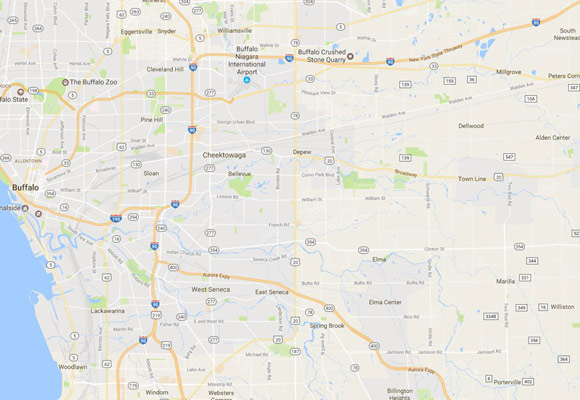
Pest Animal Removal Buffalo Exterminator Wildlife
Welcome to Pest Animal Buffalo! We are a wildlife removal company servicing Buffalo, NY. We are a family run wildlife control company with 24/7 technicians in your area. We don't ever use poisons in our wildlife control work, mostly because they're inhumane and ineffective, but also because they're more dangerous for the rest of the household. We like to pride ourselves on a number of things, our humane practices being just one of them, but also our outstanding dedication to customer care. We know that you want the job done properly, and that's just what we do with a rigorous and extensive commercial or residential property inspection that will isolate those areas vulnerable to animal attack. Whether it's an emergency critter situation - a raccoon in your kitchen, for example - or a more long-term job - removing a colony of bats from the attic - we're the right guys (and girls) for the job, with over a decade of experience behind us, and the proud owner of the #1 metropolitan area wildlife control company top-spot for 3 years running. Our specialized area is the extraction of bat colonies, but there isn't a job too big or too small for us. If you can do the job yourself, we'll even give you free advice over the phone to do just that. When we come in to do the job, we'll use the most humane method possible, using exclusion devices before anything else, and only using live cage traps as a last resort. Give us a call for your free wildlife control quote today, or just for a friendly chat wildlife-related chat. Call us now at 716-650-4630 for your Buffalo wildlife control needs.
About Pest Animal Buffalo and Our Services:
Same-day or next-day appointments.
Humane wildlife trapping and exclusion.
We repair wildlife damage and prevent re-entry.
Fully New York licensed and insured.
Poison-free Buffalo rodent control - rats and mice.
Experts in New York bat removal from buildings.
Buffalo raccoon removal and skunk removal.
Removal of animals in the attic, like squirrels.
Dead animal removal, inside and outside.
Buffalo snake removal and prevention.
Buffalo bird control services.
We look forward to hearing from you!
Our Service Range

Our Service Range
We service Erie County, Niagara County, and Cattaraugus County. We service towns such as Buffalo, Lackawanna, Lockport, Niagara Falls, North Tonawanda, Olean, Tonawanda, Towns, Alden, Amherst, Aurora, Boston, Brant, Cambria, Cheektowaga, Clarence, Colden, Collins, Concord, Eden, Elma, Evans, Grand Island, Hamburg, Hartland, Holland, Lancaster, Lewiston, Lockport, Marilla, Newfane, Newstead, Niagara, North Collins, Orchard Park, Pendleton, Porter, Royalton, Sardinia, Somerset, Tonawanda, Wales, West Seneca, Wheatfield, Wilson, Villages, Akron, Alden, Angola, Barker, Blasdell, Depew, East Aurora, Farnham, Gowanda, Hamburg, Kenmore, Lancaster, Lewiston, Middleport, North Collins, Orchard Park, Sloan, Springville, Williamsville, Wilson, and Youngstown.Buffalo Wildlife Removal Tip of the Month: About Flying Squirrel
One of the more fascinating creatures in the world is the Buffalo flying squirrel. The name is
a bit misleading, because these animals cannot fly like a bird or even like a bat, but
they can glide from great heights down to the ground or between trees, or even from a
tree to a roof. Many can glide as far as 300 feet, which gives them the ability to escape
predators or find new places for food or shelter fairly easily.

The mechanism that allows the New York flying squirrel to glide comes from a webbing like area between
the arms and legs of the creature. This is made of cartilage that is extremely taut, giving the
animal the ability to glide quite well. This region is called the patagium.
In the wild a Buffalo flying squirrel's life span averages about six years. In captivity these creatures
can live up to 15 years. The primary reason they die so young in the wild is because of predators.
There are many who seek to eat these mammals, including owls, raccoons, coyotes, bobcats, cats,
snakes, and even some humans. Because predators range from ground to tree animals, and even airborne
ones in the owl, this removes any place as a safe zone for the flying squirrel. The creature is
nocturnal animal, meaning it does most of its hunting at night. They are not able to avoid most
birds that hunt during the day time so it is necessary for them to hunt at night. They will also
eat virtually any food, adapting to their environment in terms of the food source that is available.
Most New York flying squirrels in North America eat things like insects, plants, seeds, flowers, sap and fungi,
but they will eat spiders and other small creatures if necessary.
Flying squirrels mate during late February to early March. Typically when the offspring are born they live
with the mother in what is referred to as a maternal nest. The mothers provide food and safety for the young.
The males do not care for their offspring at all. When born the Buffalo flying squirrel is hairless except for its
whiskers, which the creature uses as part of its senses. The internal organs of the youth can be seen right
through the translucent skin. By their fifth week they are completely developed, and they can actually fend
for themselves and will leave the nest to care for themselves. They will be leaping and gliding by this point,
and are completely able to survive independently.

